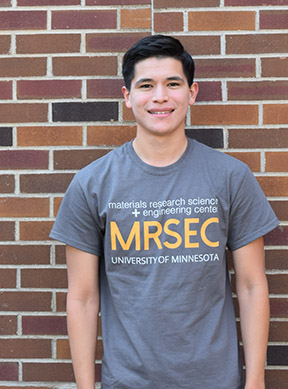
Home Institution: University of Texas Rio Grande Valley
REU Mentor: Timothy Lodge
The Conductivity and Rheology of Salt-Doped Polymer Electrolytes
Liquid electrolytes, which are used in lithium-ion batteries (LIB), show high ionic conductivity and electrolyte contact which help reduce the internal resistance. However, they are not electrochemically stable and very flammable, and thus pose significant safety concerns. Polymer
electrolytes have gained much scientific interest recently due to their potential to replace conventional liquid electrolytes. The purpose of this research is to investigate the conductivity and rheology of salt-doped homopolymers as a function of salt concentration.
Poly [oligo (ethylene glycol) methyl ether methacrylate] (POEGMA) is the polymer that is going to be worked on for this research. Electrochemical impedance spectroscopy (EIS) is an electrochemical technique to measure the impedance of a system in dependence of the AC
potentials frequency also it will be used to measure the conductivity. While dynamic mechanical spectroscopy (DMS) will be used to probe the rheological properties, which is a technique where kinetic properties are analyzed by measuring the strain or stress.
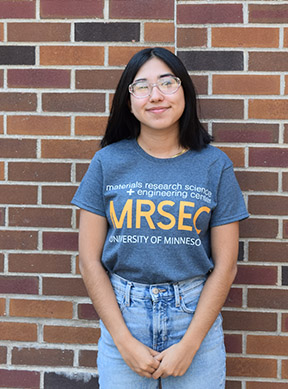
Home Institution: New Mexico State University
REU Mentor: David Poerschke
Understanding the Oxidation Behavior of Polymer-Derived SiC and Doped NbSi2 Ceramics
Recently there has been an increased demand for high temperature structural materials whose properties exceed those of conventional Ni-based alloys and monolithic ceramics. Therefore this project, will examine doped NbSi2 and SiC-based polymer-derived ceramics
that could show improved resistance to environmental degradation at elevated temperatures. Al, Cr, and Ti-doped NbSi2 ceramics, will be made by spark plasma sintering (SPS) elemental powders followed by annealing. For the SiC specimens, SiC powder is mixed
with 1 vol% TiSi2 powder, which is used as an oxygen marker, and pressed into pellets. These pellets will be infiltrated with an allyl-hydrido-polycarbosilane (SMP-10) ceramic-forming polymer precursor. Subsequent pyrolysis in argon at 900°C transforms
the infiltrated SMP-10 into amorphous Si-(O)-C. By varying the number of polymer infiltration and pyrolysis cycles and performing annealing treatments before oxidation, the porosity, crystallinity, and composition of the Si-(O)-C phase can be controlled.
The oxidation resistance of the ceramics will be explored in temperature ranges of 900-1500°C inside a tube furnace under a constant flow of dry air. Cross-sectional SEM and EDS analysis will be used to characterize and gauge oxidation resistance in both material
systems. For the NbSi2 samples we will also measure mass change per surface area and compare the results to similar compositions with a goal of mass gain less than 2 mg/cm2. In the SiC specimens we will show how porosity, composition, and crystallinity of the
polymer-derived Si-(O)-C phase influence oxygen transport and how TiSi2 can be used to gauge the oxygen partial pressure during oxidation tests.
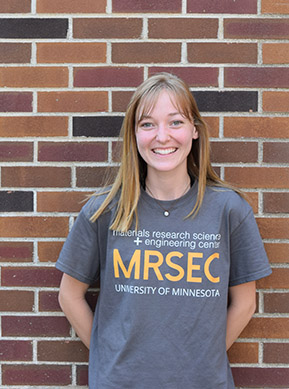
Home Institution: Augsburg University
REU Mentor: Chris Leighton
Search for ferromagnetism in p-type FeS2 and Weyl semimetal behavior in Co1-xFxS2
Pyrite FeS2, commonly known as Fool’s Gold, has recently garnered a lot of focus for potential use as a solar cell material and its potentially interesting magnetic properties. While FeS2 is a diamagnetic semiconductor, doping with cobalt is known to induce
ferromagnetism and it was recently predicted that p-type FeS2 could introduce a ferromagnetic ground state. In this project, I will look for ferromagnetic behavior in p-type FeS2 single crystals doped with phosphorus. This will involve magnetometry in a
SQUID magnetometer. In addition we will also investigate the heavily cobalt doped FeS2 for the possibility for a Weyl semimetal behavior which is currently a high interest topic in the solid state physics community. This will involve growing Co1-xFexS2
crystals using chemical vapor transport and doing electrical transport measurements in a cryostat, looking for signatures of Weyl semimetal behavior such as large anomalous Hall Effect.
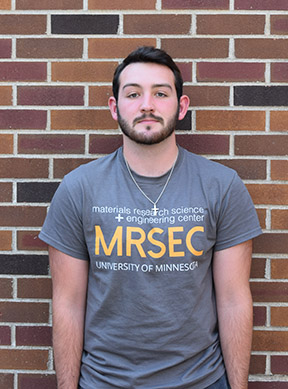
Home Institution: Florida State University
REU Mentor: Mahesh Mahanthappa
Frank-Kasper Phases in Ternary Oil/Water/Cationic Surfactant Mixtures
Ionic surfactants, which are compounds with a hydrophobic tail covalently bonded to an ionic hydrophilic headgroup with a charge-compensating counterion, self-assemble in the presence of water to form lyotropic liquid crystals (LLCs). Self-assembly is driven by the
solvation of ionic head groups and aggregation of hydrophobic tails. Anionic alkylcarboxylate and alkylphosphonate surfactants form low symmetry LLCs, specifically qausispherical micelles called Frank-Kasper phases. Self-assembled quasicrystals form when adding oil
to these LLCs, in regions between crystalline and glassy phases depending on the order of component mixing. This project focuses on studying analagous effects in surfactants with cationic head groups, in order to see if similar effects are observed. Specifically,
the first surfactant LLCs studied will be based on trimethylnonyl ammonium chloride. Other counterions will also be studied such as iodide, bromide and sulfonate. It is hypothesized that multiple Frank-Kasper phases may be identified in addition to quasicrystals
depending on how these systems are mixed. The main characterization techniques that will be utilized are Nuclear Magnetic Resonance (NMR), Elemental Analysis, Small-angle X-ray Scattering (SAXS). NMR and Elemental Analysis are used to confirm product purity
and residual water content. SAXS, the primary mode of characterization for this project, provides a diffraction pattern from which a single or combination of crystalline structures can be identified. Samples for SAXS will be prepared by mixing surfactant, water and
oil and homogenizing with centrifugation and hand-mixing to target specific molar concentrations.

Home Institution: University of Texas at El Paso
REU Mentor: Bharat Jalan
Understanding the correlation between structure and electronic properties in complex thin films
Functional oxides show important electrical and magnetic ground states such as ferroelectricity, ferromagnetism, and superconductivity. Their electronic and magnetic properties are strongly depended on their crystal structure. Recently perovskite SrSnO3 (SSO)
has attracted a lot of interest due to its large band gap of ~4 eV and high room temperature electron mobility. These properties make SSO a promising material candidate for optoelectronics and high-power electronics applications. Similarly, rutile RuO2 which is
a good catalytic electrode material, when highly strained, has shown superconductivity properties at low temperatures. However, the correlation between the structure and electronic properties of these important class of materials has not been well studied.
My research will focus on studying the phase transition and metal insulator transition in thin films of SSO and RuO2 thin films, respectively. For this purpose, we have grown high structural quality epitaxial thin films of SSO and RuO2 using hybrid molecular
beam epitaxy (MBE). The phase transition in SSO thin films will be investigated using temperature dependent X- ray diffraction (XRD) studies. Temperature dependent electron transport measurements on these thin films will be performed to study the correlation
between phase transition and the electroconductivity. We will also investigate electrical transport properties of RuO2 thin films of different crystalline orientations to understand the relation between the structure and electronic properties. Furthermore,
electrical transport properties of RuO2 thin films as a function of film thickness will be studied for the presence of possible thickness dependent metal-insulator transition.
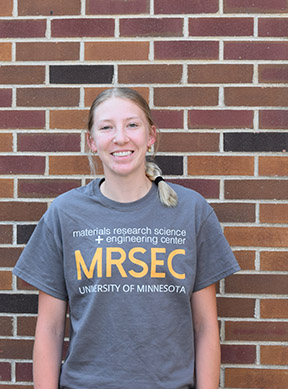
Home Institution: Augsburg University
REU Mentor: Chris Leighton
Investigating Weyl semimetal behavior in Co3Sn2S2 single crystals and thin films
Weyl semimetal behavior is a hot topic of interest in the solid state physics community. Co3Sn2S2 (shandite) has recently been found to exhibit some of these exciting ferromagnetic properties of a Weyl semimetal. In this work we will develop single crystal growth
of shandite using chemical vapor transport and optimize the growth of thin films using an ex situ sulfidation technique. We will use X-ray diffraction, scanning electron microscopy, and atomic force microscopy to characterize the structure and composition of
these crystals and films. After growth optimization we will use electrical transport and magnetometry to investigate the Weyl semimetal behavior, perhaps eventually using electrolyte gating to tune these exciting electronic properties.
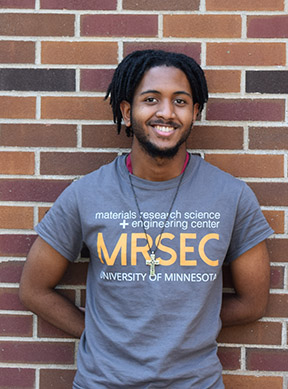
Home Institution: Penn State University
REU Mentor: Christopher Ellison
The Effects of Lower Temperatures on the Toughness of Isotropic Polylactide with added Polyethylene Oxide-Polybutylene Oxide Copolymers
In today’s world, plastics are essential to industry and everyday life. Petroleum based synthetic plastics such as polyethylene terephthalate (PET), polyethylene (PE), and polyvinyl chloride (PVC) rule the plastics industry. The world currently produces more 380
million tons of these plastics per year. However, as the production of these petroleum based plastics increase so does their accumulation in landfills and leakage into the environment. One way to combat these ramifications is to make plastics sustainable, i.e. biodegradable
and biosourced, which lessens leaching of the plastics into the environment. We still have a long ways to go in terms of making plastics more sustainable, but one plastic in particular, polylactide (PLA), has made many advances toward such a future. PLA is a biosourced
and industrially compostable polymer and has applications ranging from 3D printing filament to packaging industries. However, PLA becomes very brittle over time due to physical aging. PLA’s brittleness decreases its toughness significantly compared to other commercial
plastics, which limit its applications. Recently, however, it has been found that mixing the liquid diblock copolymer, polyethylene oxide-polybutylene oxide (PEO-PBO), with PLA, toughens the PLA by initiating uniform crazing when under stress. However a majority of the
research done with the PEO-PBO/PLA blend described before has been done at room temperature. We present the effects lower temperatures have on the tensile strength and toughness of isotropic 5% wt. PEO-PBO/PLA blend and propose solutions and specific parameters for the
polymer blend to maximize toughness at lower temperatures.
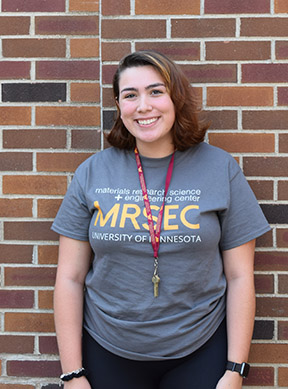
Home Institution: University of Texas Rio Grande Valley
REU Mentor: Christopher Ellison
University of Texas Rio Grande Valley
In this thesis, we examine the difference in common use plastics utilized to make the plastic bottles seen in stores today and the problems associated by recycling. This is accomplished by taking the two most common plastics polyethylene (PE) and
linear low-density polyethylene (LLDPE) to make films by melt blending in order to create a different definition of recycling by reducing the need for manual sorting. The general standard in recycling processes is to reprocess them into blend products for
post-consumer needs. Unfortunately, this method is flawed due to polymer degradation because of the depletion of mechanical properties such as the tensile strength. When mixing the materials, hydroxy-telechelic polyethylene (PEOH) is added when in the PET in small
amounts to create a transesterification reaction. In this reaction data is utilized for analysis and data visualization to prove the form of block polymers (BCPs) within the compatibilization of the LLDPE-PET blend.
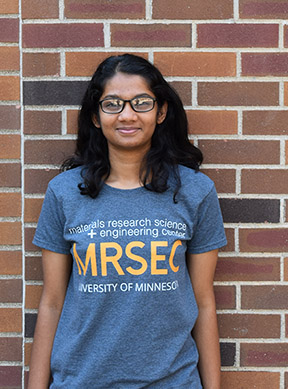
Home Institution: Iowa State University
REU Mentor: David Poerschke
Investigation of silicate induced degradation resistance of multi-phase yttrium and gadolinium zirconate- aluminate compounds
Ceramic coatings are used in jet engines and gas turbines to protect the structural parts of the hot gas path. Single-phase and two-phase coating materials have been studied in-depth, but they don’t meet the most demanding performance requirements. Multi-phase coatings
could be used to take the advantage of multiple advantageous thermochemical, thermophysical, and thermomechanical properties. Multi-phase rare earth aluminate zirconate coatings in yttria and gadolinia systems have been identified as potential candidates for
coating materials. The rare earth (RE) oxide to zirconia ratio has been noted in the past as a key parameter influencing resistance to degradation caused by molten calcium-magnesium alumino- silicate deposits (CMAS). The addition of alumina is anticipated to
improve the CMAS resistance. Therefore, it is important to understand how coating compositions with varying molar ratios of REO1.5 (RE = Y, Gd), ZrO2, and AlO1.5 could lead to better coating materials. Oxide powders with varying molar ratios of REO1.5, ZrO2
and AlO1.5 will be synthesized by reverse co-precipitation using calibrated precursor solutions. The powders will be sintered at temperatures > 1400ºC to produce porous pellets. X-ray diffraction analysis (XRD) and scanning electron microscopy (SEM) analysis
will be used to characterize the materials. The main goal is to examine the resistance of these ceramic coating materials when they are attacked by CMAS deposits, whereas these coating materials must possess thermochemical, thermophysical, and thermomechanical
properties such as high toughness, low sinterability, and low coefficient of thermal expansion.
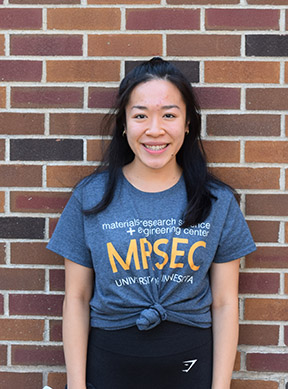
Home Institution: Carnegie Mellon University
REU Mentor: Michelle Calabrese
Characterization of Shear Banding Properties of Wormlike Micelles with Slow Dynamics
Shear banding is a flow instability where, beyond a critical stress or shear rate, a homogeneous fluid flow separates into distinct regions or “bands” of viscosity, shear rate (slope of fluid velocity), and underlying structure. Although shear banding has received considerable
attention, the mechanism of shear band formation is unclear. Suggested mechanisms in literature include nucleation and growth and disentangle-re-entanglement, but the criteria for selecting one mechanism over another for a given material and flow are unknown. We explore these
mechanisms by studying the shear banding evolution of wormlike micelles (WLMs), the archetypical system for these instabilities, across a variety of flow conditions. Here, these long, entangled micelles are composed of triblock poloxamers, which rearrange and break on slow timescales.
Consequently, we obtain a greater understanding on how the system changes as analysis progresses. The anisotropy in WLMs and especially changes in the shape of velocity profiles with time are indicative of the mechanism the system undergoes to achieve shear banding. As shear bands
are localized structures that vary in both space and time, particle tracking velocimetry (PTV), a velocity measurement with spatiotemporal resolution, is utilized to characterize shear banding evolution. We intend to first improve the resolution of the technique by mitigating
aggregation and optimizing the instrument’s camera and laser parameters. Furthermore, small-angle neutron scattering (SANS) and shear rheology provide complementary information on the local microstructure and mechanical response of the shear bands, respectively. Together these
three measurements provide a comprehensive picture of the shear bands across length scales.

Home Institution: University of Maryland, Baltimore County
REU Mentor: Benjamin Hackel
Sequence activity mapping and engineering of lactococcin G
The need for new antibiotics has never been greater due to the increasing threat of antibiotic resistance. New therapeutics are direly needed to resist pathogenic microorganisms, which has led to a swell of research surrounding antimicrobial peptides (AMPs).
One such AMP is Lactococcin G, whose activity depends upon the complementary activity of two peptides (α and β) that forms a potassium ion channel in gram positive bacteria. Lactococcin G requires undecaprenyl-pyrophosphate phosphatase (uppP), a transmembrane protein,
for activity and is the putative lactococcin G partner protein eliciting antimicrobial activity. We aim to perform deep mutational scanning of lactococcin G and uppP to deduce sequence determinants of lactococcin G activity, uppP susceptibility, and lactococcin G-uppP
interaction. We hypothesize mutational synergy among double mutants across lactococcin G and uppP will reveal residues in close proximity, empowering us to hypothesize the lactococcin-uppP interface and (hopefully) a structural basis for the putative three-component
potassium-selective ion channel. In order to deeply quantify sequence activity relationships via SAMP-Dep, a recent high-throughput platform for AMP activity quantification, we must: (1) understand why Escherichia coli is not susceptible to lactococcin G and how to
modify E. coli to become susceptible to lactococcin G, mimicking L. lactis, and (2): establish whether SAMP-Dep works with lactococcin G and determine the conditions at which SAMP-Dep efficiently and accurately pairs AMP sequence to activity. Our work will set the foundation
for future researchers to screen lactococcin G activity against uppP at the library scale via SAMP-Dep.
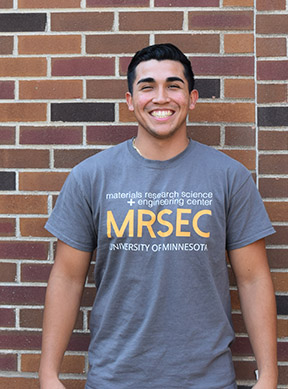
Home Institution: University of Texas at El Paso
REU Mentor: Tristan Truttman
Scientific Instrument used to analyze metal acetylacetonate precursors
Achieving stoichiometric control within Molecular Beam Epitaxy (MBE) by using organic sources to open the growth window to make high mobility oxide films. The purpose of this project is to assemble a scientific instrument that will allow for metal acetylacetonate
precursors or organic sources to be analyzed by quantifying the evaporation of the compounds and their impurities. This test chamber is initially being assembled using a CAD software called Solidworks. Once assembled, Yttrium acetylacetonate [Y(acac)3] will be
compared to Ruthenium acetylacetonate [Ru(acac)3], which has successfully opened the growth window before in previous experiments. The hypothesis surrounding the comparison of these two metal organic sources would be in that Yttrium(acac) will contain similar
characteristics as Ruthenium(acac) by creating a stoichiometric ratio with the complex compound being mobilized and opening the growth window which will allowing for a complete doping of that complex compound resulting to a Perovskite structure.

Home Institution: University of Texas Rio Grande Valley
REU Mentor: Andre Mkhoyan
Multislice Image Simulations for analysis of Experimental Transmission Electron Microscope Images for perovskite oxides
PYCCO perovskite oxide films grown on different substrates have been studied over the past and have had a great impact recently for their great application in electronic devices. This has created a need to further study these materials at the atomic scale.
Characterization at this length-scale can be achieved by using an aberration corrected Scanning Transmission Electron Microscope (STEM) which allows a resolution of about 0.7Å which is sufficient enough to see the atoms of the materials. In order to study the thin PYCCO films
in the electron microscope, the samples are prepared by using the technique Focused Ion Beam which allows us to obtain a cross-section that is about 50 nm film which will then be observed in the STEM to obtain atomic resolution images of these materials on two different substrates.
The major focus of this experiment will be to match the experimental results by carrying out image simulations and image analysis on MATLAB. These image simulations will be done using the code Multislice where the crystal is divided into slices to carry out quantum mechanical
calculations to resemble the environment inside an electron microscope. These simulations would require inputs from the experimentally used parameters during the image acquisitions. Two main modes of operation will be considered: one is conventional TEM mode which simulates the
focal series to match with the experimental focal series to identify the best focus condition. The second would simulate a high angle annular dark field (HAADF)-STEM images to match the experimental data. A comparison would then be made to study image interpretation in both
modes versus the experiments. The simulations are relevant to getting the best imaging of the crystals since it allows us to have an idea of what we want the image to look like and adapt the focus to get an image close to that of the simulation.
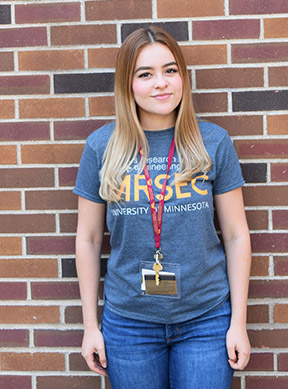
Home Institution: University of Texas Rio Grande Valley
REU Mentor: Phil Engen
Effects of Nanoparticle inclusion on rheology of poly(acrylamides)
Silica nanoparticles have been found to improve the macroscopic characteristics of polymer solutions significantly. My project aims to investigate phase separation following the addition of silica nanorods to an aqueous polymer solution at various temperatures.
I will begin by synthesizing nanoparticles, as per my mentor's instructions. The nanorods will then be dissolved in a mixture of polymers and water. Then, using a turbidity tester, I will track light transmission through the samples as a function of temperature, looking
for when the solutions phase separate and how this temperature changes when nanoparticles are added. I will also use a rheometer to look at how flow properties like viscosity and dynamic moduli change with temperature by using oscillatory temperature ramps and frequency
and amplitude sweeps. Finally, using a magneto-rheometer to apply a magnetic field during these tests will reveal how these systems are affected by magnetic field.
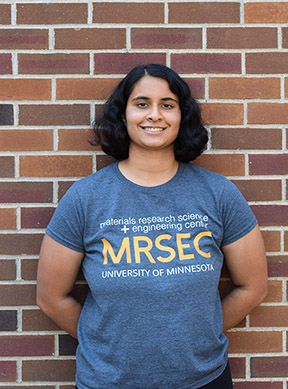
Home Institution: Cornell University
REU Mentor: Martin Greven
Effect of Ionic-Liquid-Gating on Plastically Deformed Strontium Titanate and Iron Selenide
It has recently been demonstrated that the electronic properties of quantum materials can be manipulated with plastic deformation. Plastically deformed strontium titanate SrTiO3 (STO) single crystals exhibit superconductivity markedly above the superconducting
transition temperature (Tc) of undeformed STO. It is well-established that ionic-liquid-gating of quantum materials can also alter their electronic properties. Pristine STO acts as an insulator (resistance on order of 106 Ω). However, pristine STO is observed to be
metallic (resistance on order of less than 103 Ω) when a gate voltage of +3 V is applied. Our goal is to apply both plastic deformation and ionic gating in combination to materials to observe any potentially exotic electronic properties. The two materials to be explored
are STO and iron selenide [Fe(Se,S)]. To determine changes in Tc of the altered materials, we will probe them with an AC magnetic field and measure their first and third harmonic magnetic response. The first harmonic magnetic response decreases sharply on cooling below Tc.
Thus, we can use it to determine Tc. The third harmonic magnetic response becomes nonzero when superconducting puddles begin to form in the material, before the entire substance becomes superconductive. Thus, we can use it to determine the onset of superconducting correlations.
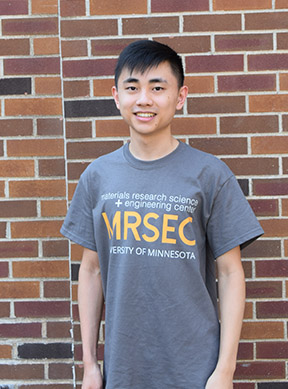
Home Institution: University of California, Santa Barbara
REU Mentor: Cari Dutcher
Phase Studies of Sea Spray Aerosol Droplets Using Microfluidic and Optical Techniques
Sea spray aerosol (SSA) droplets are an abundant aerosol species known to affect Earth’s climate through radiative forcing and cloud nucleation. However, current climate models cannot fully account for the radiative forcing associated with aerosols, due to high uncertainty
stemming partially from the lack of characterization of chemical and phase behaviors of salt and organic matter in aging SSAs. Here, we incorporate microfluidic and drop-on-slide techniques for model SSA systems, with a focus on evolution through time, to gain insights into
the phase transitions and crystal morphologies of SSAs. Through quasi-equilibrium pervaporation, we observe a single efflorescence transition in our model systems. When observing the final crystal morphology, the addition of fatty acids creates an optically opaque, disrupted
crystal, while the addition of glucose leads to an amorphous solid. Effloresced SSA droplets are scanned three-dimensionally using Raman spectroscopy to determine the assembly of fatty acids, glucose, and salts. We see an enrichment of fatty acids on the surface of effloresced
SSA droplets, as suggested by computational modeling. Our conclusions from single particle experiments on the fundamental properties and assembly of SSA droplets are used to evaluate the UCSD Amaro group computational SSA model conclusions.
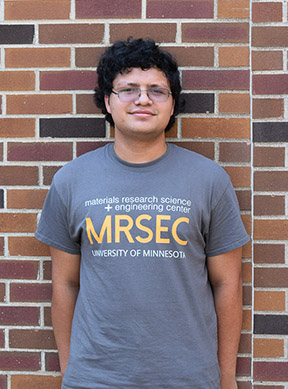
Home Institution: University of Texas Rio Grande Valley
REU Mentor: Mahesh K. Mahanthappa
Evaluating the Order to Disorder Effects of an Oxanorbornene Backbone for Bottlebrush Polymers
Polymers are a growing field in material science research for their ability to self-assemble themselves into microphases. The project focuses on synthesizing densely grafted core-shell bottlebrush (csBB) polymers that order themselves into lamellar structures with finite domain spacings.
Microchips and various electrical components, have small groove-like patterns that serve as the device’s storage. Engineers are reaching the physical limits of manufacturing these components and are now turning to molecular templates to create smaller patterns. Polymers are particularly
interesting for these applications since they are easily manipulated into different architectures. The lamellae structure can potentially form sub 14-nm domain spacings which would increase the current storage density by approximately eight times. The system follows high “𝜒” low “N” with
a high repulsion between chains (𝜒) and a small degree of polymerization (N). While at room temperature, this csBB polymer is in an ordered state but transitions to the disordered state as it is heated. This transition can be quantified as the order-to-disorder transition
temperatures (TODT) which can be used to determine various physical and thermodynamic properties.
The bottlebrush itself is synthesized from a difunctional oxanorbornene initiator followed by sequential ring-opening transesterification polymerization (ROTEP) of ε-decalactone and lactide, followed by a ring-opening metathesis polymerization (ROMP) to afford a dimethanol
oxanorbornene backbone densely grafted with poly(ε-decalactone-b-lactide) arms.
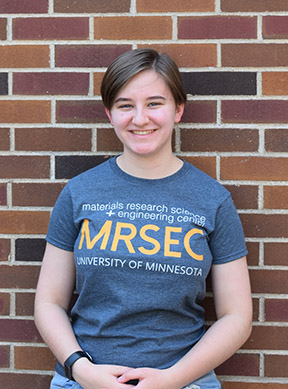
Home Institution: Rose-Hulman Institute of Technology
REU Mentor: David Frisbie
Optimization of ZnO Floating Gate Transistors for Small Molecule Sensing Applications
Electrochemical biosensors are of interest to replace analytical instrumentation for sensitive detection of small molecule hazards. The floating gate, electrolyte-gated transistor (FGT) is an electrochemical sensing platform that shows promise due to its low-voltage
operation and high capacitances. High sensitivity toward target molecules can be achieved by tailoring the device architecture, materials, and use of a resistor-loaded inverter. Large and charged molecules, like DNA and proteins, have been successfully detected with an FGT,
but small molecule detection has yet to be demonstrated. To achieve the desired sensitivity toward small molecules while ensuring the device upholds the additional necessary analytical figures of merit, such as reproducibility and low limit of detection, the semiconductor of
the FGT will be switched from a printed, organic semiconductor to a vapor-phase deposited metal oxide, ZnO. Transistor fabrication with ZnO entails use of atomic layer deposition for ZnO deposition, photolithography for electrode patterning, and aerosol jet printing for the
electrolyte deposition. With this, tens of devices can be fabricated at a time with minimal variability with respect to semiconductor properties, yet other variables, such as electrolyte thickness, electrode sizing, and relative humidity can prevent high reproducibility and
stability over time. Such variables will be investigated by recording transfer curves, inverter curves, and the displacement current to determine how they affect key transistor characteristics, including the trip voltage, specific capacitance, and mobility for ZnO. Models for
FGT sensitivity will be exploited to further optimize toward small molecule sensing based on findings of key ZnO FGT characteristics.
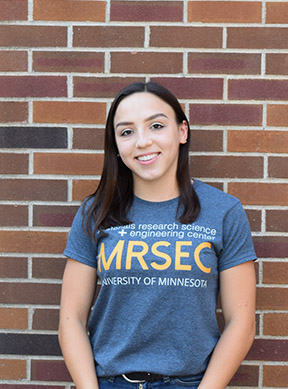
Home Institution: New Mexico State University
REU Mentor: Tim Lodge and Frank Bates
Accessing Complex Nanoscale Packings with ABA’ Triblock Copolymers
Formed by combining chemically distinct polymer blocks, block copolymers are used across several industries owing to their ability to self-assemble at the nanoscale. Of particular interest in recent years has been the discovery that these ostensibly simple materials
can order into micelles arranged on large, complex Frank–Kasper (FK) lattices. Frank–Kasper (FK) phase formation in diblock copolymer melts is largely based on three parameters: block volume fraction, molecular weight, and conformational asymmetry. Less explored,
however, is how their formation can be driven in triblock copolymers. This research studies this question with a particular focus on ABAʹ triblock copolymers with variable core (A) block lengths. We hypothesize that an asymmetry in the core block lengths will open up a
FK phase window. Polymers will be synthesized by ruthenium-mediated ring-opening metathesis polymerization (ROMP). Volume fraction and core block length asymmetry will be varied to yield symmetric and asymmetric triblock copolymers. Polymers will then be characterized by
proton nuclear magnetic resonance spectroscopy (1H NMR) and size exclusion chromatography (SEC). Following, small angle X-ray scattering (SAXS) will be used to assess polymer nanostructure. Order–disorder and order–order transitions will then be determined using rheology.
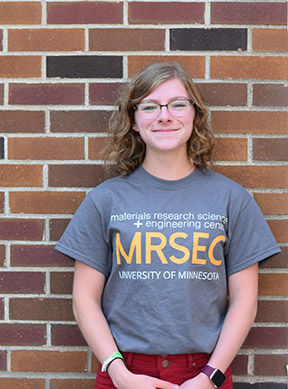
Home Institution: Georgia Institute of Technology
REU Mentor: Nathan Mara
Creep Behavior of Austenitic Stainless Steels Using Nanoindentation Techniques
Austenitic stainless steels are being explored as structural materials for use in Gen-IV nuclear reactors for their mechanical performance in high temperature, irradiative environments. Since long-term mechanical performance is crucial for nuclear reactor applications, SS347
austenitic stainless steel alloy is being studied for its high temperature creep resistance and corrosion properties. The creep behavior is being studied at high temperatures and room temperature using nanoindentation, a small-scale mechanical testing method. Current bulk creep
tests are very long and nanoindentation offers a more throughput method to analyze creep properties on a shorter time frame. Using a Berkovich indenter geometry and strain rate jump tests, the hardness will be measured to obtain the strain rate sensitivity. Next, the Oliver and
Pharr method will be applied to determine the stress exponent and activation energy to analyze creep mechanisms. Characterization using electron backscatter diffraction (EBSD) and scanning electron microscopy (SEM) will be used to analyze how different microstructures affect
the mechanical behavior of the material. Finally, the results for SS347 alloy will be applied to develop a model to predict the bulk properties of heterogeneous alloys. Overall, this project will further develop nanoindentation techniques with different indenter tip geometries
and methods to analyze creep on a smaller scale than current bulk creep tests.
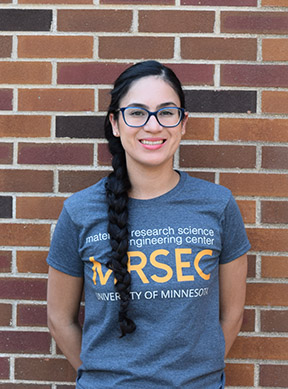
Home Institution:
REU Mentor:
Mixing dynamics of bilgewater emulsions in Taylor Couette flows
Taylor-Couette flows between two concentric, rotating cylinders, is ideal for studying the mixing dynamics and stability of emulsions due to the availability of wide variation of hydrodynamic flow states. The need to control the concentration of oil discharge at sea from the
marine vessels require a better understanding of the stability and formation of Navy standard bilge mix emulsion (50% marine diesel fuel, 25% steam lube oil, 25% Diesel lube oil) onboard these ships. The importance of this study is to help prevent as much oil spills from marine
vessels into the ocean that endanger natural resources, aquatic life, public health, our economy and more. In this study, a pre-prepared (IKA: T-25 digital Ultra-Turrax) concentrated oil-water emulsion is directly injected into the annulus of the Taylor-Couette cell containing
surfactant-water solution at varied flow conditions to determine the intermixing rate or dispersion rate of the emulsion. The optical properties of the Tayler-couette cell enables us to visually study the mixing and spread of the emulsion in the solution. It is expected that
the dispersion coefficient will show an approximately linear response to increasing inner cylinder speed of Taylor-couette cell. Samples will be collected at different mixing stages from the TC cell during the experiments and laser diffraction particle analyzer will be used to
characterize droplet size distribution for those mixing stages. The measurements will indicate the droplet breakup or shear induced coalescence in terms of droplet size distribution. Which will be used to determine the conditions for formation of stable bilge emulsions. In this
study, my work will be more specific to performing laser diffraction measurements on the samples collected during the mixing studies using particle diffraction analyzer and optical microscopy.
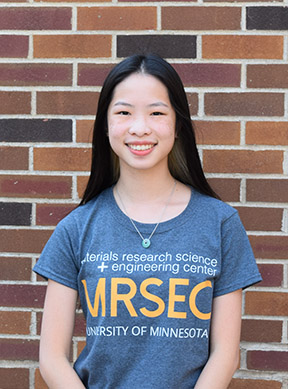
Home Institution: Florida International University
REU Mentor: Ke Wang
Investigation of Anisotropic, Nodal, and Topological Material Properties in 2D Superconductors
Superconductivity of 2D materials, specifically transition metal dichalcogenides (TMDs) are of current interest due to their unique symmetry properties. This study focuses on the development of 2D superconducting devices and the investigation of the properties of NbSe2.
Computer-aided design (CAD) software will be used to design multi-layer devices, which will be assembled with a combination of dry transfer techniques and nanofabrication. Beginning with the exfoliation of outer device layers such as graphene and hexagonal boron nitride (hBN),
thin layers of these materials will be obtained and characterized. This is conducted using a simplified practice of continuous mechanical exfoliation to obtain few-layer flakes of each material. Characterization of these metal flakes will be conducted using atomic force microscopy.
In addition, heavy emphasis in this study is placed on the dimensionality and topology of the metal flakes and their effect on device superconductivity. Electrical transport measurements will be obtained at low-temperature, and the data analysis will be conducted in MATLAB. Due
to results from previous testing on NbSe2, it is expected that it will demonstrate layer-dependent anisotropic symmetric superconductivity when under the effect of a rotated magnetic field.
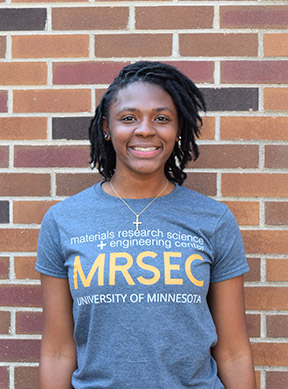
Home Institution: Dillard University
REU Mentor: Ben Hackel
Testing of proline- rich antimicrobial proteins (PrAMPs)
With antibacterial resistance on a rise, healthcare systems around the world are seeking alternatives to fighting infections. Various organisms produce antimicrobial peptides (AMPs) as a defense against pathogens invading the host. AMPs work against bacteria, fungi, and viruses
to kill the given target by lysing the membrane once catabolic and hydrophobic components of the AMP and membrane attract and interact. In the family of AMPs are a group of proline-rich AMPs (PrAMPs) that act by inhibiting ribosome function and ridding the cells of protein that
is essential for growth. The effectiveness of different PrAMPs continues to be tested. With the previous library testing completed on the PrAMP oncocin in Escherichia coli via SAMP-Dep, a new platform effectively quantifying AMP activity, the group will move forward with testing
the effectiveness of Metalnikowin 1, Pyrrhocoricin, and Tur1a on E. coli mutational libraries. Each of the PrAMPs will be placed into their individual plasmids and transformed into bacteria. Isopropyl β- d-1-thiogalactopyranoside (IPTG) will be used as an inducer that will express
the given PrAMP within the bacterial cell. Bacteria that show a decline in growth as IPTG concentration increases convey that the PrAMP is effective against E. coli. Conversely, bacteria that show an increase or no change in growth rate convey that the given PrAMP is not effective.
Based on the information that is known of the three given PrAMPs, it is expected that those most like oncocin- Metalnikowin 1 being the closest- will cause the bacteria cells to die.
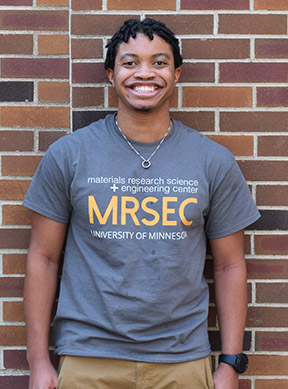
Home Institution: University of Minnesota - Twin Cities
REU Mentor: Renee Frontiera
Plasmonic Photocatalyzed Reaction Outcomes of Differing Excitation Methods Using Surface Enhanced Raman Spectroscopies
Surface enhanced Raman Spectroscopy (SERS) is a well-known method of enhancing the Raman signals caused by Raman scattering in plasmonic materials. Photons involved with Raman scattering are particles emitted that are of a higher or lower energy than the incident light
used to excite the plasmonic system. In previous studies, various experiments have been conducted to determine the dependence of SERS on variables such as distance, substrates, size of nanoparticles, along with other parameters. SERS is now being investigated to be
catalytically applied to different organic and perhaps inorganic reactions. For this experiment, different modes of system excitation will be used to dimerize 4-nitrobenzenethiol to 4,4-dimercaptoazobenzene. The results could provide some insight into how to control the
outcome of reactions through different excitation methods. Additionally, manipulation of the reaction efficiency and yield could be better understood. Ultrafast and continuous-wave (CW) irradiation methods will be applied to the system of interest for analysis. Considering the
difference in output energy provided by the lasers (assuming both methods have equal average output power), it is possible that there could be differences amongst excitation methods; some methods may provide more energy to the system than other methods. Whichever methods provide
the energy required for the system to undergo the prescribed reaction in higher yield would be the dominant excitation method. All in all, exploring the effects of different excitation methods could allow future experiments regarding chemical reactions to be conducted in a more
efficient manner.
School: White Bear Lake High School
Mentor: Jane Wissinger
Title: Green Applications of Seaweed: Edible/Degradable Calcium Alginate Capsules
Edible, biodegradable calcium alginate capsules are synthesized using safe, readily available materials, sodium alginate, a derivative of seaweed, and calcium lactate. The capsule outer membranes are a result of ionic interactions between specific carboxylate groups from
different alginate strands and the divalent calcium cations between them, thus forming cross-linked polymers. When the carboxylate groups on the alginate strands are protonated, crosslinking is inhibited, preventing formation of the capsules. In the first part of this experiment,
various concentrations of citric acid are used to lower the pH of the sodium alginate solution and the effect of calcium alginate capsule formation is observed. As pH decreases the capsules are less firm, oblate, or do not form at all. In the second part of this experiment, cranberry
juice, apple juice, and lemon juice, rather than water, are used in the synthesis of the calcium alginate capsules. The impact of the concentration and natural acidity of the juice on capsule formation is studied. Learning outcomes include simple bonding, acid/base chemistry,
polymer structures, and green chemistry concepts. Students consider the environmental challenges of traditional plastics and how innovative products, like NotPLA, are attempting to provide solutions.
School: Waconia High School
Mentor: Vivian Ferry
Title: Illuminating Luminescent Solar Concentrators
The green energy revolution has begun and solar cells on homes, businesses and schools are becoming a common sight. Traditional solar cells obstruct light and require a large surface area. Luminescent Solar Concentrators (LSC) combine the function of a solar cell with the
practicality of a window. We developed a high school appropriate project involving Luminescent Solar Concentrators that will engage the students in exploring the properties of LSC while learning about the concepts of light and optics. We utilized non-toxic organic dyes to
create LSC paints that can be applied to a waveguide. The type of LSC paint and number of layers can be tested under a variety of light sources while intensity of luminescence is measured using the light sensor on an Ipad.
School: Thomas Edison High School
Mentor: Mark Distafano
Title: An Example of Phenomenon-Based Learning Through the Exploration of Protein Prenylation in Algae
The 2019 Minnesota State Science Standards are shifting focus from content-driven learning to the use of scientific practices to explore and understand new phenomena. This project will use protein prenylation in algae as an anchoring phenomenon in both biology and chemistry
courses to support a collaborative multi-year project. Students in chemistry will learn the synthesis of a fluorescent prenylation probe through a click reaction. Students in biology will use a synthesized probe to prenylate proteins in algal cells and visualize the resulting
product using gel electrophoresis and staining.
School: White Bear Lake High School
Mentor: Jane Wissinger
Title: Green Applications of Seaweed: Edible/Degradable Calcium Alginate Capsules
Edible, biodegradable calcium alginate capsules are synthesized using safe, readily available materials, sodium alginate, a derivative of seaweed, and calcium lactate. The capsule outer membranes are a result of ionic interactions between specific carboxylate groups from
different alginate strands and the divalent calcium cations between them, thus forming cross-linked polymers. When the carboxylate groups on the alginate strands are protonated, crosslinking is inhibited, preventing formation of the capsules. In the first part of this experiment,
various concentrations of citric acid are used to lower the pH of the sodium alginate solution and the effect of calcium alginate capsule formation is observed. As pH decreases the capsules are less firm, oblate, or do not form at all. In the second part of this experiment, cranberry
juice, apple juice, and lemon juice, rather than water, are used in the synthesis of the calcium alginate capsules. The impact of the concentration and natural acidity of the juice on capsule formation is studied. Learning outcomes include simple bonding, acid/base chemistry,
polymer structures, and green chemistry concepts. Students consider the environmental challenges of traditional plastics and how innovative products, like NotPLA, are attempting to provide solutions.
School: St. Paul Central High School
Mentor: Vivian Ferry
Title: Illuminating Luminescent Solar Concentrators
The green energy revolution has begun and solar cells on homes, businesses and schools are becoming a common sight. Traditional solar cells obstruct light and require a large surface area. Luminescent Solar Concentrators (LSC) combine the function of a solar cell with the
practicality of a window. We developed a high school appropriate project involving Luminescent Solar Concentrators that will engage the students in exploring the properties of LSC while learning about the concepts of light and optics. We utilized non-toxic organic dyes to
create LSC paints that can be applied to a waveguide. The type of LSC paint and number of layers can be tested under a variety of light sources while intensity of luminescence is measured using the light sensor on an Ipad.
School: Thomas Edison High School
Mentor: Mark Distafano
Title: An Example of Phenomenon-Based Learning Through the Exploration of Protein Prenylation in Algae
The 2019 Minnesota State Science Standards are shifting focus from content-driven learning to the use of scientific practices to explore and understand new phenomena. This project will use protein prenylation in algae as an anchoring phenomenon in both biology and chemistry
courses to support a collaborative multi-year project. Students in chemistry will learn the synthesis of a fluorescent prenylation probe through a click reaction. Students in biology will use a synthesized probe to prenylate proteins in algal cells and visualize the resulting
product using gel electrophoresis and staining.
School: Mankato West High School
Mentor: Lee Penn
Title: Analyzing Iron Oxides: Seeing the Unseen
Science requires observation. In chemistry, observations of change in color, mass, and heat can be exciting, but they can further provide clues as to what is occurring deeper within the particles and atoms. Crystals of iron oxides (iron rusts) made under various
conditions (pH, time, temperatures, ion presences) can provide an opportunity for student analysis and provide clues into their formation and structure. Using steel wool, students will be challenged to make rust. While the rust formed is visible, identifying the types of rust
requires analysis--as there are sixteen iron oxides and iron oxyhydroxides. At a high school level, this analysis can include a visible identification, a streak test, and a check with a magnet. However, a deeper analysis can include a check with an RGB color picker (using a computer
or mobile phone app) or, with a university connection, powder XRD (X-ray diffraction). Student learning outcomes will include material synthesis and applying various methods for analysis. The analysis provides opportunities for students to open the door to deeper skills and
technologies and allows them to see the unseen. Student-produced iron oxide samples can be compared to standardized samples created and characterized at the University of Minnesota.
UMN MRSEC
435 Amundson Hall, 421 Washington Ave. SE, Minneapolis, MN, 55455
P: 612-626-0713 | F: 612-626-7805